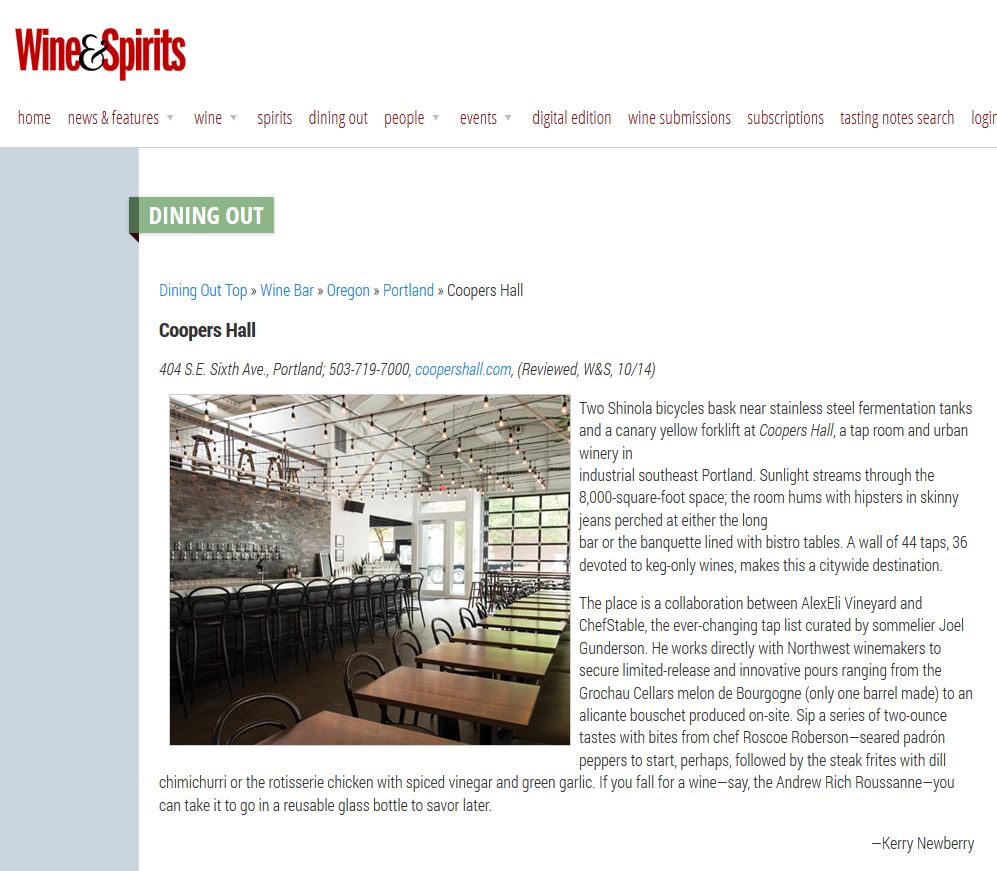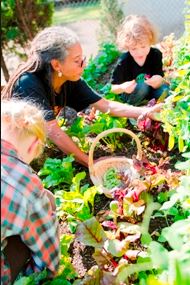Vital Stats from the Field: Virginia Garcia Memorial Health Center

Virginia Garcia Memorial Health Center’s outreach team travels to farm camps, providing healthcare for 1,800 migrant farmworkers each year.
Rosalia Ginsberg sits under a canopy of cottonwoods, the summer sun still high in the sky. When the balmy wind blows, the shiny leaves ripple together and make a distinctive sound similar to the sea at a distance. This is Cornelius, however, in Yamhill County, and it is too far away to hear the melody of the sea. Ginsberg is at Casa Blanca, a migrant farmworker camp, one of fifteen in the area.
At an intersection of country roads that evokes Americana, a church billboard proclaims: God Bless America. Hand- etched produce signs, fields of green and nostalgic barns paint the agrarian landscape, reminiscent of The Saturday Evening Post. Old pick-up trucks roll past distant mountain peaks and big blue sky. This is Oregon farm country and at first glance, it appears little has changed in the past 30 years.
Ginsberg, however, would disagree. A registered nurse who has worked with the migrant farm community since 1978, she has seen the tides of change. In 1975, a young girl named Virginia Garcia and her farmworker parents traveled from their home in Mission, Texas to California and Oregon to work in the fields. Along the way, Virginia cut her foot, and by the time they reached Oregon, it had become infected. Due to economic, language and cultural barriers to healthcare, Virginia passed away
on Father’s Day as her own father was working in the fields picking berries.
The community immediately responded. Moved to action by tragedy, local physicians, community leaders and farmworker families rallied for a program that could provide comprehensive and culturally appropriate healthcare to those in need, and the first Virginia Garcia Memorial Health Center launched in a three-car garage.
“I started working at Virginia Garcia in 1978,” says Ginsberg. “Last year was 30 years.” She was running the pharmacy and the lab in those days because her nursing license was from Argentina. Ginsberg’s singsong accent is from South America. “I’m Paraguayan, yes,” she says. Most of her statements end with a soft, high-pitched affirmation, followed by a smile that begins with her eyes.
“I invented my job, I tell people,” she says, her eyes crinkling at the corners, just before the smile takes over.
“Curiosity was the thing,” she says. “I wanted to know where they were coming from.” She’s talking about the migrant farmworkers she would see walking the country roads from the camps to the clinic. “I started to pick them up along the road,” she explains. At that time, the grassroots Virginia Garcia clinic had one to two doctors serving hundreds of workers.
After Ginsberg received her nursing license to practice in Oregon, she suggested visiting the farmworker camps with the doctor and health educators she was working with at Virginia Garcia, and the migrant outreach program was born. In those days, the outreach was comprised of a handful of caretakers caravanning to fields, the car brimming with supplies.
“We started visiting camps with the van around fifteen years ago,” she says. “It was with the Northwest Medical Teams van at first.” The van proved transformative. “There was no privacy before. We had to put the doctors in a shower or a room full of onions—the chiropractor was doing all his work under the trees,” she says, followed by her lyrical laughter. “I did the triage most of the time, always in the outdoors.” Ginsberg sits on a plastic chair with a folding table, under the shade of trees. “We are still outdoors,” she acknowledges. Songbirds chime in, as if in agreement.
A patient walks up and perches on a second plastic chair. Ginsberg leans in, speaking soft Spanish. Five feet away, the mobile clinic door opens and another patient walks out with two children. Inside, two Spanish-speaking healthcare workers, either physicians or medical assistants, are equipped to provide primary care, obstetrics/prenatal care, immunizations and treatment for diabetes and asthma.
The outreach unit services more than 1,800 migrant farmworkers a year, with a team of providers, nurses and health educators traveling to the camps offering onsite treatment and education. The health education focuses on sexually transmitted diseases, pesticide exposure, sun care, depression and prevention of work-related injuries.
This work is crucial, as farmworkers experience many on-the-job health problems, such as respiratory disease, parasites, skin infections, heat-related illnesses and chemical poisoning. In fact, the General Accounting Office (1992) reports farm work as the most dangerous occupation in the United States. The life expectancy of migrant farmworkers is 49 years compared to the national average of 73 (Center for Disease Control, 1998). And according to the National Center for Farmworker Health, 70 percent of the agricultural-worker population does not have health insurance.
The outreach team at Virginia Garcia begins preparing for the summer programs in February, collaborating with donors, partners and volunteers, seamlessly transitioning into spring, literally ready to roll. The mobile clinic visits nine camps in Washington County and four in Yamhill County, roving between a handful each Monday, and then alternating between specific camps on Tuesday and Thursday nights from May through August.
A typical summer evening starts with the camp set up, a fine-tuned process. “Our staff and volunteers set up everything: tables, chairs and tents,” explains the bright-eyed and exuberant Olivia Mackenzie, assistant outreach coordinator. Any large trees serve as ample shade for the triage and registration tables.
Sergio Camargo, a quiet man with a shiny black walrus moustache that dances upward with his smile, readies the medical van each night, parking it on level ground and powering the air- conditioning, if needed. “He is our jack of all trades,” says Mackenzie. “Once the camp kicks in, he might assist with registration, blood pressure and general tasks around camp.”
Volunteers stock the van with medicine and supplies, as well as the triage table where Ginsberg sits. “She’s here every night,” says Rosa Rivera, outreach coordinator. “And she sees every single patient.” The doctors see the patients Ginsberg can’t treat. “Rosalia, though— she sees every single one.”
After about two months, the lengthy set- up is streamlined to a mere ten minutes from beginning to end.
As the camp kicks into action, Mackenzie greets at registration. “The number of patients can vary quite a bit,” she says. “I would say that on average, we see about 30 patients each night.” In the smaller camps, the number might be closer to ten or fifteen, but at the largest camp, the outreach team has treated up to 125 patients in one night.
Two volunteers assist Ginsberg at triage. This usually involves dispensing medication and making sure all patients receive the “bolsitas.” “These are small bags filled with hygiene items, soap, toothpaste, shampoo…whatever goods we have on hand,” says Mackenzie.
The triage table sees a lot of colds, sore throats and rashes, “and you can take a deep breath with those,” says Ginsberg. Tendonitis and chronic back and wrist pain are common ailments too.
In addition to treatment, the providers conduct preventive exams. This is especially significant, as many of the workers have lapses in healthcare. The Farmworkers in Oregon Report (2000) published by the League of Women Voters found that more than 40 percent of all farmworkers who visit health clinics have multiple and complex health problems. Additionally, because of limited access to healthcare, farmworkers are often seen only when their health problems are at an advanced stage.
In cases where more serious help is required, Virginia Garcia will provide transportation to one of their main clinics. “We have a pretty complete program now, with a lot of educators and resources and providers,” says Ginsberg. “It’s been nice to see the progress,” she says. “And I am very honored to have been doing this job.”
What began as a three-car garage clinic in response to community need has grown into four primary care clinics, three dental offices and two school-based health centers that serve more than 30,000 patients a year in Washington and Yamhill Counties. In addition, of course, is the mobile outreach van that provides care to the migrant workers, who make up 19 percent of the patients served by Virginia Garcia today.
Rivera credits many of the partnering organizations with the success of the program. During the busiest summer months, the Oregon Food Bank collaborates with local churches to bring food staples to the camps. The clinic also works with WIC (providing educational and emotional support to young mothers) and LifeWorks Northwest, a nonprofit, community-based prevention, mental health and addiction agency. Pacific University’s School of Optometry administers vision services to patients in need.
The Oregon Child Development Coalition, one of the largest early childhood care and education networks in Oregon, offers the Migrant Seasonal Head Start Program during the peak agricultural months, when parents’ need to work often conflicts with childcare during the day.
“The younger children are picked up every day at 5 a.m. for Migrant Head Start, even Saturdays and Sundays, because the workers are in the field seven days a week,” says Rivera. The Hillsboro School District arranges evening classes for workers aged 16 to 21, with transportation to and from the schools.
Other partner organizations serve with the volunteers at the camps. “Usually we have two to five different organizations at camp with us providing education of some sort,” says Mackenzie. Katherine Bakke, a summer intern from Bryn Mawr college, tracks the education each night at the camp. “For example, if we have Cascade AIDS come with us to camp to do education, Katherine would keep track of how many patients received that information.”
Additional volunteers oversee donations, start up games or reading circles with the kids, and on occasion, join in on impromptu soccer games.
Qualified volunteers assist with the blood pressure and glucose checks that every registered patient receives. Bristol Schmitz, a pre-med student from Notre Dame taking a year off to work with Virginia Garcia, is able to step into this role. “That is, until a soccer game is going on,” says Mackenzie jokingly.
The enthusiasm and energy from the volunteers can transform what really is a somber scene. According to an Oregon Health & Science University report, Reducing Pesticide Exposure in Minority Families, migrant farmworkers are among the most disadvantaged, medically indigent persons and have the poorest health of any group in the United States.
Ginsberg knows. “I love all these young volunteers that come,” she says, her eyes glistening. “They are so loving and they are capable of doing so many things. They want to learn. They want to see how they can be helpful to society,” she says. “Each of them wants to make the world better somehow.”
“It gives me hope, it really does,” she says.
A similar sentiment reflects in the workers’ eyes. Men in broad-brimmed hats wind around the trees and into the sunlight. Children prance around the van, under the portrait of a young and smiling Virginia Garcia. So many lives, young and old, are touched each summer.
“Well, you don’t do it for that,” says Ginsberg quietly. “It’s your job, of course. But then you have to have a certain type of calling to do it. It’s late. I have my husband that is waiting. But it doesn’t matter,” she says. “This needs to be done. That is why we are here.”
The story of the Virginia Garcia Memorial Health Center certainly inspires, and it is difficult to capture the fortitude, from vision to reality. The clinic has quadrupled in size over the past dozen years and the services continue to expand with the help of donors and partnering organizations. It is phenomenal.
“I’ll tell you the secret,” Ginsberg says, leaning in, the cottonwood leaves whispering above. Black cropped curls frame her beatific face. Her eyes crease softly at the corners as she turns thoughtful and smiles.
“Where there is need, there is love.”
Edible Portland | Fall 2009
Click here to read the article on the Edible Portland website http://edibleportland.com/vital-stats-from-the-fields/.





